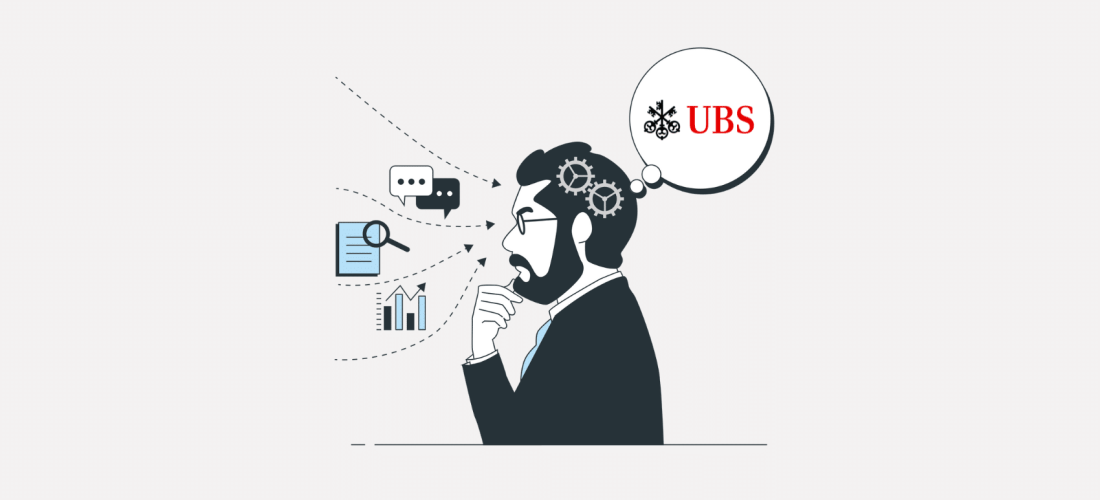What is the 3rd pillar?
1. Pillar 3a (tied pension provision): primarily intended for retirement, it offers significant tax advantages by allowing contributions to be deducted from taxable income. For 2025, the maximum amount deductible is CHF 7’258 for employees affiliated with a pension fund. In return, the capital remains locked in until retirement, except under specific conditions (home purchase, moving abroad, starting self-employment).
1. Pillar 3a (tied pension provision): mainly intended for retirement provision, it offers significant tax advantages but imposes certain withdrawal conditions. Amounts paid in are tax-deductible up to the statutory limits (CHF 7,258 for employees affiliated to a pension fund in 2025).
2. Pillar 3b (unrestricted pension provision): more flexible, allowing more flexible use of accumulated savings. UBS offers a wide range of products, including investment plans, mutual fund accounts, securities custody accounts and term deposits.
UBS 3rd Pillar A solutions
UBS structures its offering around two complementary products: the Vitainvest funds for those seeking returns through financial markets, and the Fisca 3a account for those who prioritize absolute security.
1. Vitainvest funds: active management
UBS’s flagship offering is built around a range of seven actively managed funds, all labeled “Sustainable.” These funds differ based on two main criteria: their geographical focus (Switzerland or Global) and their equity allocation (25%, 50%, 75%, or 100%).
Vitainvest World: these funds invest globally, with at least 70% of foreign currency exposure hedged into Swiss francs. The goal is to limit the impact of currency fluctuations on performance. Global geographical diversification provides broad exposure to various markets.
Vitainvest Swiss: these funds focus on the Swiss market (mainly Swiss equities, bonds, and real estate denominated in CHF). This approach suits investors who prefer domestic exposure, though it comes at the cost of reduced geographical diversification.
The “multi-manager” concept is a distinctive feature of the Vitainvest funds. UBS relies on several renowned external asset managers (including Allianz Global Investors, NinetyOne, Schroder, and PIMCO) who apply different investment styles. This approach aims to diversify not only the holdings but also the management strategies.
Key features
- Periodic or one-off payment as required
- Active management with tactical adjustments to market conditions
- Diversification through multi-assetequities, bonds, real estate
- ESG criteria applied to stock selection
2. Vitainvest Passive funds: the indexed alternative
Pour les investisseurs soucieux des coûts ou convaincus par la gestion passive, UBS propose quatre fonds indiciels: Vitainvest Passive 25, 50, 75 et 100 Sustainable. Ces fonds répliquent des indices de marché et ne cherchent pas à les battre, ce qui permet de réduire les frais de gestion.
The allocation follows a logic similar to that of the active funds, with different equity/bond weightings tailored to various risk profiles. The passive approach offers greater transparency: investors know exactly what they hold, and the strategy does not depend on a manager’s discretionary decisions.
Key features
- Low management costs compared to active management
- Replication of'market indices
- Four risk profiles available (25% to 100% shares)
- Sustainable approach integrated
3. Fisca 3a: the risk-free solution
The Fisca 3a account is designed for those who prefer to take no market risk. It operates like a traditional savings account with a guaranteed interest rate. This solution is particularly suitable for individuals nearing retirement or those who are highly risk-averse.
L’avantage principal réside dans la prévisibilité totale: le capital versé est garanti à 100% et génère un intérêt fixe connu à l’avance. L’inconvénient majeur est un rendement généralement faible, souvent inférieur à l’inflation, ce qui peut éroder le pouvoir d’achat sur le long terme.
Key features
- Lower risk of capital loss
- Guaranteed interest rate
Should I invest in ESG funds?
UBS systematically applies ESG criteria (environmental, social and governance) to its entire Vitainvest range. All funds are labelled «Sustainable» and exclude certain controversial activities: arms, tobacco, coal, oil and gas to a certain extent.
Cette orientation durable répond à une demande croissante des investisseurs, mais soulève aussi des questions légitimes. Les fonds durables ont-ils vraiment une meilleure performance à long terme ? La réponse honnête est : pas nécessairement. Les données historiques montrent que l’intégration de critères ESG peut parfois restreindre l’univers d’investissement au point d’impacter les rendements potentiels, notamment en excluant certains secteurs performants. Les fonds Vitainvest Sustainable figurent toutefois parmi les produits ESG les plus aboutis du marché suisse, grâce à une sélection rigoureuse et une méthodologie transparente.
Cependant, il serait réducteur de tout ramener à la performance pure. L’investissement durable permet d’aligner ses placements avec ses valeurs personnelles, ce qui représente une véritable valeur ajoutée pour de nombreux épargnants. Les critères ESG peuvent également servir de filtre pour repérer les entreprises mieux gérées sur le long terme, même si cet avantage reste sujet à débat.
How much does the UBS 3rd pillar cost?
For active funds: taking the example of Vitainvest World 100 Sustainable, the ongoing charges amount to 1.63% per year. This figure includes the management fee (1.28%) and other operational costs. In addition, there are transaction costs that are not included in the stated ongoing charges.
Over the long term, these fees have a significant impact. An investment of CHF 100,000 over 30 years with a 6% gross return would grow to about CHF 574,000. With annual fees of 1.63%, the net return drops to 4.37%, and the final capital reaches only CHF 353,000. The CHF 221,000 difference purely reflects the cumulative effect of fees over three decades.
For passive funds: using the example of Vitainvest Passive 100 Sustainable with 0.25% in annual ongoing charges, the picture changes completely. Over the same 30-year period with a 6% gross return, the net return comes out to 5.75%, resulting in a final capital of CHF 521,000. The difference compared to active management? More than CHF 168,000 lost solely due to higher fees.
Active vs. passive at UBS
The contrast between the two UBS fund ranges is worth highlighting. With ongoing charges of just 0.25% per year, the Vitainvest Passive funds are highly competitive. This cost structure allows investors to retain most of the market’s return.
This comparison highlights the importance of fees over the long term. However, active management can create value in several ways: by limiting losses during market downturns, by overweighting growth sectors, or by exploiting market inefficiencies. The question is therefore not whether 1.63% is «expensive» in absolute terms, but whether active management generates enough added value to make up the difference.
Pillar 3a highlights at UBS
- Ultra-competitive passive funds with only 0.25% annual fee
- Solid performance for active funds (7,58% annualized over 5 years for the World 100)
- Sustainable multi-manager style that provides additional diversification
- Large and established Swiss bank with financial strength
- Wide range of funds adapted to different risk profiles
- Possibility ofonline subscription without any appointment
Pillar 3a weaknesses at UBS
- High costs on active funds (1,63%), which had a significant impact on net return
- Systematic sustainable approach without alternative for those who do not want an ESG filter
- High variation in fees between active and passive management (1.38 percentage points)
- The active funds must generate outperformance to justify their additional cost
Conclusion
The UBS 3rd Pillar offers two distinct options, depending on whether you opt for active or passive management, each meeting different needs.
The Vitainvest passive range represents an excellent option for investors focused on cost optimization. With fees of just 0.25% per annum, it captures the bulk of financial market returns while benefiting from the strength of UBS. It's the most rational option for savers with a long-term horizon who want a simple, efficient solution.
The Vitainvest active range is aimed at a different audience. Recent performance (7,58% annualized over 5 years) shows that active management can deliver solid results. The multi-manager concept brings a diversification of approaches that can be valuable, particularly in difficult markets. The fees of 1,63% are certainly high, but they are part of a full-service approach that includes the expertise of several recognized managers.
Frequently asked questions
Simply fill out the transfer order form for your 3a retirement assets, then send it to your current institution. It will then arrange for your assets to be transferred to the UBS SA Fisca Pension Foundation.
Active funds (1.63% in fees) call on several managers who attempt to beat the market through their investment choices and tactical allocation. Passive funds (0.25% fees) simply replicate market indices. Both approaches have their merits: active funds have generated 7.58% per annum over 5 years, which is respectable, but the lower fees of passive funds give them a structural advantage over the long term.
Yes, very competitive. This is one of the the cheapest of the Swiss market for a pension solution with the solidity of a major bank.
Global geographic diversification (World) is generally preferable for spreading risk. The Swiss market is excellent, but concentrated in a few sectors and has underperformed in recent years. World funds offer broader exposure to different global economies and sectors.
The minimum annual premium is around CHF 600 for versions 3a and 3b. For the SmartFlex income plan, the initial contribution must be at least CHF 15,000.
Historically, equity investments have delivered higher long-term returns than so-called “safe” assets such as bonds or savings accounts. If you have more than 15 to 20 years before retirement, allocating a portion to equities is often recommended to generate stronger returns.
The key is to adjust the allocation to your risk profile and gradually reduce the equity portion as you approach retirement.





